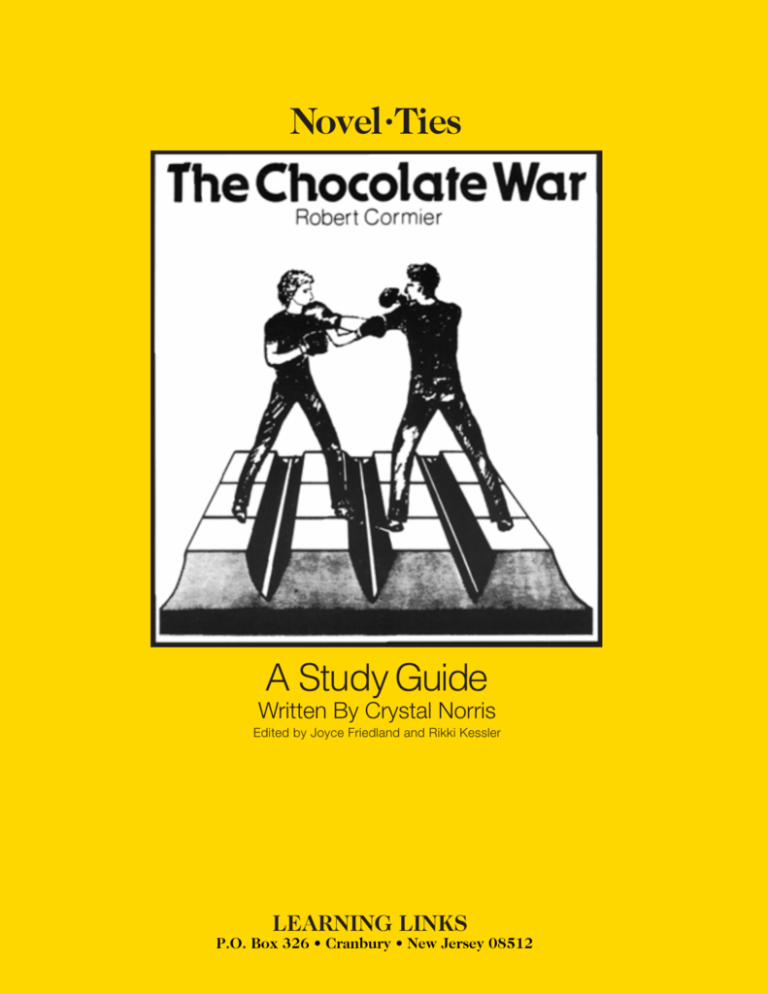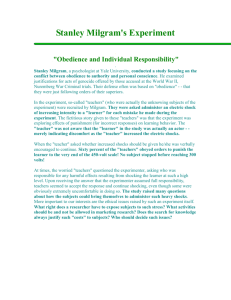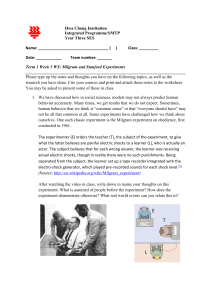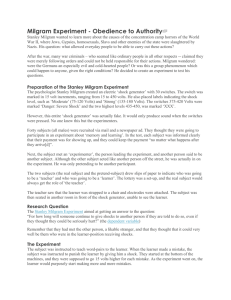Novel•Ties A Study Guide
advertisement

Novel •Ties A Study Guide Written By Crystal Norris Edited by Joyce Friedland and Rikki Kessler LEARNING LINKS P.O. Box 326 • Cranbury • New Jersey 08512 THE CHOCOLATE WAR TABLE OF CONTENTS Synopsis . . . . . . . . . . . . . . . . . . . . . . . . . . . . . . . . . . . . . 1 About the Author . . . . . . . . . . . . . . . . . . . . . . . . . . . . . . 2 Pre-Reading Activities . . . . . . . . . . . . . . . . . . . . . . . . . . 3 Chapters 1 - 3 . . . . . . . . . . . . . . . . . . . . . . . . . . . . . . 6 - 7 Chapters 4 - 6 . . . . . . . . . . . . . . . . . . . . . . . . . . . . . 8 - 10 Chapters 7 - 12 . . . . . . . . . . . . . . . . . . . . . . . . . . . 11 - 14 Chapters 13 - 16 . . . . . . . . . . . . . . . . . . . . . . . . . . 15 - 18 Chapters 17 - 20 . . . . . . . . . . . . . . . . . . . . . . . . . . 19 - 21 Chapters 21 - 25 . . . . . . . . . . . . . . . . . . . . . . . . . . 22 - 23 Chapters 26 - 30 . . . . . . . . . . . . . . . . . . . . . . . . . . 24 - 26 Chapters 33 - 39 . . . . . . . . . . . . . . . . . . . . . . . . . . 27 - 28 Cloze Activity . . . . . . . . . . . . . . . . . . . . . . . . . . . . . . . . 29 Post-Reading Activities. . . . . . . . . . . . . . . . . . . . . 30 - 31 Suggestions For Further Reading . . . . . . . . . . . . . . . . 32 Answer Key . . . . . . . . . . . . . . . . . . . . . . . . . . . . . . 33 - 35 Novel-Ties® are printed on recycled paper. The purchase of this study guide entitles an individual teacher to reproduce pages for use in a classroom. Reproduction for use in an entire school or school system or for commercial use is prohibited. Beyond the classroom use by an individual teacher, reproduction, transmittal or retrieval of this work is prohibited without written permission from the publisher. Copyright © 1987, 1996, 2008 by LEARNING LINKS THE CHOCOLATE WAR For the Teacher This reproducible study guide consists of instructional material to use in conjunction with the novel The Chocolate War. Written in chapter-by-chapter format, the guide contains a synopsis, pre-reading activities, vocabulary and comprehension exercises, as well as extension activities to be used as follow-up to the novel. NOVEL-TIES are either for whole class instruction using a single title or for group instruction where each group uses a different novel appropriate to its reading level. Depending upon the amount of time allotted to it in the classroom, each novel, with its guide and accompanying lessons, may be completed in two to four weeks. The first step in using NOVEL-TIES is to distribute to each student a copy of the novel and a folder containing all of the duplicated worksheets. Begin instruction by selecting several pre-reading activities in order to set the stage for the reading ahead. Vocabulary exercises for each chapter always precede the reading so that new words will be reinforced in the context of the book. Use the questions on the chapter worksheets for class discussion or as written exercises. The benefits of using NOVEL-TIES are numerous. Students read good literature in the original, rather than in abridged or edited form. The good reading habits formed by practice in focusing on interpretive comprehension and literary techniques will be transferred to the books students read independently. Passive readers become active, avid readers. LEARNING LINKS THE CHOCOLATE WAR PRE-READING QUESTIONS 1. Preview the book by reading the title and the author’s name and by looking at the illustration on the cover. What do you think this book is going to be about? Do you think it will be humorous or serious? Have you read any other books by the same author? 2. Who are the leaders in your school? Are they the athletes, the brightest students, the best-looking students? How do these people assert their power and/or influence? How do they retain their influence? 3. Hazing, a common practice in many high schools and colleges, is the subjection of newcomers to abusive tricks and ridicule. Is there any form of hazing at your school? Do you think hazing should ever be permitted? 4. What is a bully? How do bullies operate, and who do they select as victims? What permits bullies to flourish? Are there any instances in your own neighborhood or school where bullies threaten others? 5. Discuss peer pressure with your classmates. Why are teenagers particularly prone to peer pressure? What makes them want to conform? What would make you break away from the pressure of your peers? Recount incidents of pressure and rejection of peer standards that you have experienced or witnessed. 6. A “whistle-blower” is someone who risks position and personal safety to report an instance of malfeasance within an institution. Do you know of any incidents at school, at work, or that you have read about where someone has “blown the whistle” on a colleague? Do you think this person made the right decision? What happened to the “whistle-blower” in each case? Why do you think “whistle-blowers” often suffer for their acts? 7. Cooperative Learning Activity: Work with a cooperative learning group to develop a list of actions that would be so terrible as to cause you to risk your own welfare in order to end them. Discuss where you would draw the line between tolerance for differences and rejection of the truly evil. Compare your list with those of other groups in your class. 8. Read the Two Experiments in Social Psychology on pages four and five of this study guide and answer the questions that follow. Discuss these experiments with your classmates to prepare you for the issues you will read about in The Chocolate War. LEARNING LINKS 3 THE CHOCOLATE WAR Pre-Reading Activities (cont.) I I. Conformity and Obedience to Authority In 1963 Stanley Milgram devised an ingenious experiment2 which showed that most people will go to extreme lengths to obey the voice of authority, even though that authority may be unjust. In Milgram’s experiment, two persons were assigned different roles—the “learner,” who was actually acting out Milgram’s instructions, and the teacher,” who was the real subject of the experiment. The teacher and the learner were told that they were involved in a study on the effects of punishment on memory. The teacher was instructed to administer shocks of increasing intensity every time the learner answered incorrectly on a series of paired-word associations. Then the teacher and the learner were led into a room where the learner was strapped into an electric chair and hooked up to an electrode. (Even though the electric chair was incapable of transmitting electric shocks, the teachers were led to believe that the chair did work.) The teacher was then led into an adjacent room which had a panel of four lights on which the learner’s answer choices were displayed. In this room, there was also a machine that appeared to be an electric shock generator with a panel of switches labeled from 15 volts (slight shock) to 450 volts (Danger–severe shock). Each time the learner answered incorrectly, the teacher was supposed to administer a shock. At 150 volts the learner yelled through the walls that he wanted to be let out of the experiment. The teacher was urged by the experimenter to continue giving the shocks because anything but the correct answer was considered the wrong answer. At 180 volts the learner said that he could not stand the pain; at the level of severe shock the learner pounded on the wall and wailed before he became strangely silent. Some of the teachers needed coaxing from the experimenter and many suffered from severe tension—stuttering, trembling, and sweating—but eventually 65% of the subjects obeyed the experimenter by administering shocks of increasing intensity to the end. 1. Why do you think so many people obeyed the experimenter when it seemed obvious to them that they were hurting people? 2. Under what circumstances might the teacher find it easier to disobey the experimenter and stop giving the shocks? 3. Can you think of any real-life examples of the same sort of reluctant obedience to authority? 4. Do you think there is ever a time when blind obedience to authority is a good thing? 1 Asch, S. 1958. “Effects of group pressure on the modification and distortion of Judgments.” In E.E. Maccoby, T. M. Newcomb, & E.L. Hartley (Eds.), Readings in Social Psychology. New York: Holt, Rinehart, & Winston. 2 Milgram, S. (1974), Obedience to Authority; An Experimental View. Tavistock Publications. LEARNING LINKS 5







